Lab Grown Diamonds and the "4Cs" - an overview of CVD and HPHT in relation to quality and grading
Posted by Winona Richardson, G.G. on 28th Feb 2020
While one would assume that diamonds grown in a controlled laboratory environment would be “perfect” in regards to color and clarity, this is not the case. Like other lab grown gemstones, the process of delivering an appealing lab grown diamond to the market goes well beyond simply growing the crystal and submitting it for cutting. If you are considering a lab-grown diamond, it is very important to work with a reputable gemologist/seller to ensure that your selections are accurately and ethically represented.
Although chemically identical and as durable as natural mined diamond, the Federal Trade Commission (FTC) requires lab-grown diamond manufacturers to use a qualifier that clearly distinguishes lab-grown diamonds as man-made and not of natural origin. Man made diamonds are grown from a miniscule diamond “seed” through processes involving High Pressure/High Temperature (HPHT) and Chemical Vapor Deposition CVD). Viable crystals are ready for cutting within a few weeks to several months.
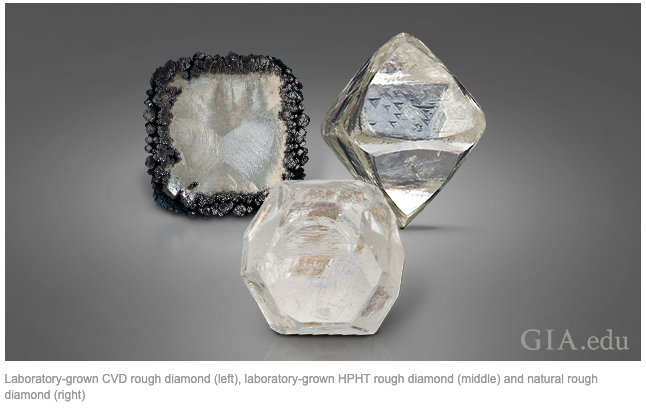
In this blog segment, I'll review how these two methods of manufacture for lab grown diamonds, how these production methods affect their classifications in the "4Cs" and how gemological laboratories address these qualities to the trade and the consumer market.
LAB GROWN DIAMOND COLOR
Lab-grown CVD diamonds are rarely “born” colorless – most CVD crystals are brownish or grayish. These undesirable brown, yellow, greenish or gray colors are removed through HPHT annealing of the material.
-CVD Diamond color before and after treatment
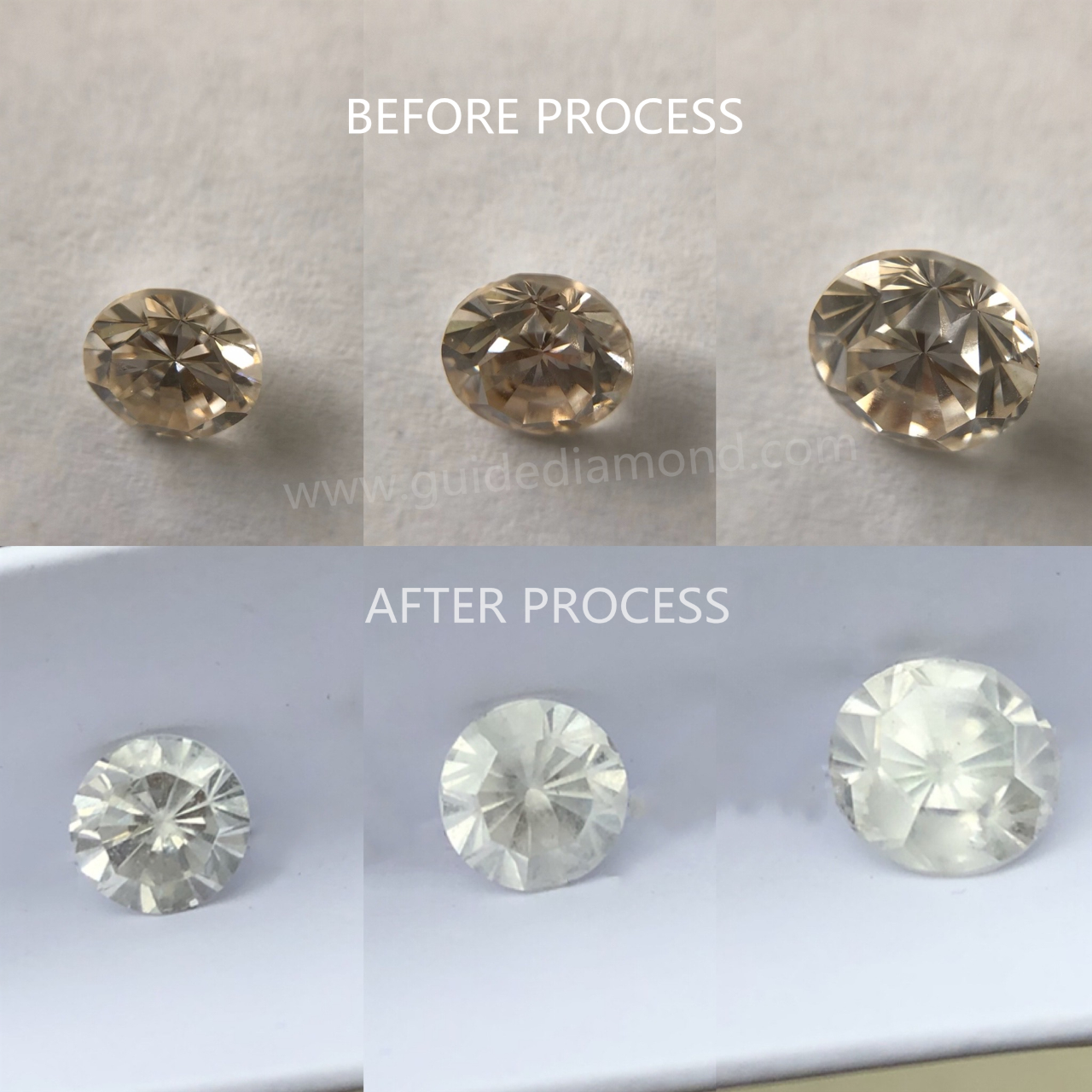
Some as-grown untreated “colorless” CVD diamonds exhibit color instability when exposed to short-range UV light or high heat and may change color to blue/gray. Exposure to sunlight will generally reverse the color change after a few hours.
The most common fancy colors exhibited in CVD lab grown diamonds are yellows and pinks. These appealing colors are induced via multiple post-growth treatments, including HPHT annealing, irradiation, and low-temperature annealing.
Earlier HPHT-grown crystals were predominantly yellow, orangey yellow, or brownish yellow. Recent progress in growth technology has allowed for better control of impurity contents, resulting in the creation of colorless crystals. Most HPHT synthetics on the D-Z color scale are believed to be as-grown (i.e., due to impurities) rather than the product of post-growth treatment processing.
HPHT Diamonds are available in a variety of fancy colors including pinks, yellow, blues, and greens. These colors are induced either by (or in tandem with) trace elements added to the growth chamber or post-growth irradiation.
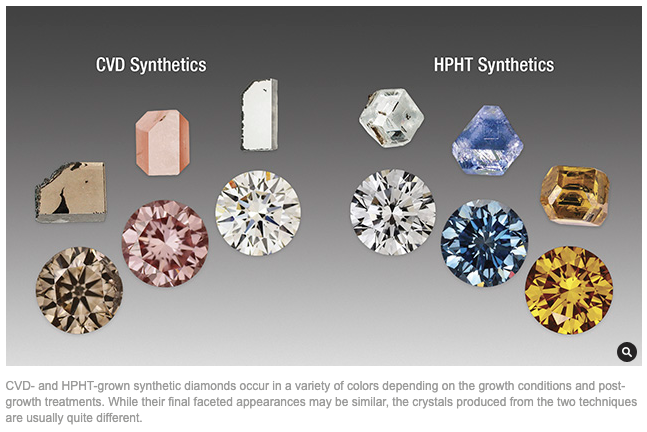
LAB GROWN DIAMOND CLARITY
The nature of inclusions in lab grown diamonds differ from those of mined diamonds and may be discerned under magnification (HPHT) and via advanced spectroscopy (HPHT and CVD).
Because the flux metal alloy used for diamond growth in HPHT applications contains elements such as iron, nickel, and cobalt, HPHT synthetic diamonds often display inclusions of solidified flux metal. These inclusions appear black and opaque in transmitted light but have a metallic luster in reflected light. Synthetic diamonds with larger metallic inclusions can be picked up with a magnet.
*Some natural diamonds contain dark inclusions of graphite or some other mineral, but these inclusions do not have a metallic luster.
CVD-grown synthetic diamond formation occurs in a different environment from that of HPHT stones; they do not have metallic inclusions. They are of high clarity with few, if any, tiny dark carbon inclusions. The small inclusions most often encountered are clouds, pinpoints, and black “crystals.” Similar clarity features are found in both natural and CVD synthetics. These inclusions are generally not diagnostic for separation identification purposes, despite the very different environments in which the materials were formed.
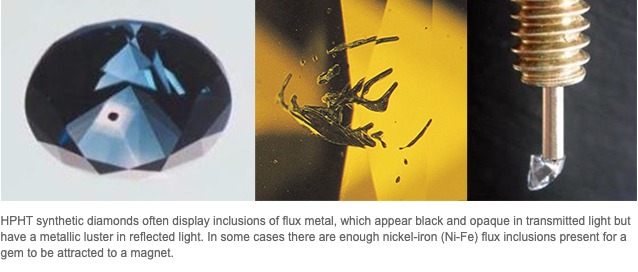
LAB GROWN DIAMOND CUT
Lab Grown Diamonds are cut in the same manner as natural mined diamonds.
Lab Grown CVD tablets typically undergo laser cutting to remove the rough outer edges of the crystal, followed by standard diamond polishing techniques.
In the CVD production method, the crystals develop in layers; the finished rough has a tabular shape. Rough crystals with such a narrow length to depth ratio can restrict options in faceting styles. With the table facet of the cut stone as the upper surface of the crystal, the cutter must contend with a small table-to-culet distance that can limit the choice of faceted shape in sizes over two carats.
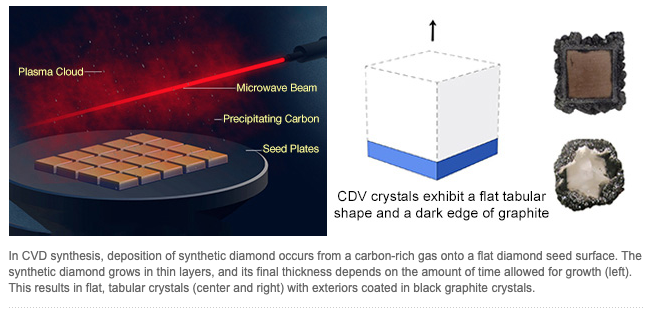
HPHT lab-grown diamond crystals have a cuboctahedral form - which overlies a geometric arrangement of octahedral, cubic, and dodecahedral internal growth sectors. This flux growth method is accompanied by the incorporation of different amounts of impurities in these distinct sectors—thus leading to a segregation of these impurities between sectors. Differential incorporation of impurities gives rise to the distinctive zoning of color, graining, and luminescence seen in many synthetic (as compared to natural) diamonds. When present, boundaries between adjacent color zones are usually sharp and planar they also may intersect to form angular patterns.
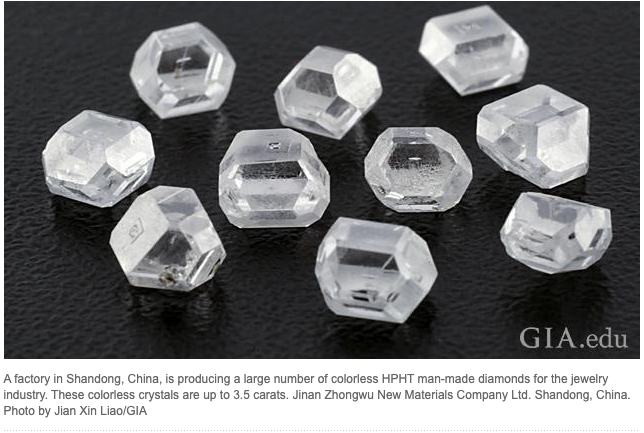
While the cutting of HPHT crystals are not limited by a flat or tabular shape (as is the case with CVD), these other factors will impact the cutting options of the material.
LAB GROWN DIAMOND CARAT WEIGHTS
In CVD growth the material deposits - layer by layer - on top of a seed plate. The longer the material grows, the larger the crystal. The tabular crystal shape of CVD diamonds, however, generally limits the faceting styles used to manufacture gem-quality material in larger sizes. As of 2019, the largest finished CVD Diamond on record at the Gemological Institute of America was under 6 carats.
HPHT growth proceeds at temperatures and pressures designed to approximate the conditions of natural diamond growth. High-pressure reactor chamber design and control of diamond growth parameters have advanced considerably in recent years. The consistent production of larger HPHT synthetics is now possible, and several HPHT synthetic crystals can be grown simultaneously within the press. Due to the nature of HPHT formation and the common presence of flux inclusions, fashioning finished specimens of high clarity can be limited regardless of the large base crystal sizes produced. HPHT gem-quality specimens over 10 carats are not common, but they are possible.
Natural mined diamonds are available in much larger sizes than lab-grown diamonds. While still substantially less expensive on the retail market than mined diamonds, lab grown diamonds of gem quality over two carats in weight command $3000 per carat – and higher. They are not inexpensive. As the technology for lab-grown diamonds continues to develop and larger specimens become more readily available, it may deflate the purchase price of lab-grown gems across the market.
OTHER LAB GROWN DIAMOND ATTRIBUTES
HPHT samples have gemological properties to diagnostically distinguish them from mined diamonds. This includes (but is not limited to) color zoning, observation of unusual ultraviolet fluorescence with a standard long-wave/short-wave UV, banded strain growth patterns, and magnetism. CVD lab-grown diamonds have few visual diagnostic gemological properties to distinguish them from natural diamonds under standard testing methods.

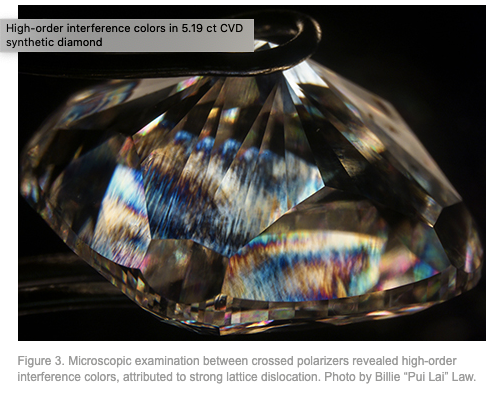
While the majority of natural diamonds (95%)are Type 1a (with concentrations of nitrogen) and all HPHT lab grown diamonds are Type 1b (with more diffuse nitrogen impurities combined with a different absorption spectrum) all CVD diamonds are Type 2a (no measurable nitrogen impurities and a distinct absorption spectrum). While it is possible to discern Type 1 from Type 2 diamonds with commercially available screening devices, to confirm that diamond flagged as Type 2 is a CVD lab-grown and not a rare, mined Type 2 diamond, advanced spectroscopic techniques are essential for a definitive analysis.

The positive identification of both HPHT and CVD synthetics is best accomplished by a major gemological laboratory that maintains a database of information on known natural, treated, and synthetic diamonds and sees a sufficient quantity of goods to spot emerging trends.
LAB GROWN DIAMOND CERTIFICATION
The Federal Trade Commission (FTC) requires lab-grown diamond manufacturers to use a qualifier that clearly distinguishes lab-grown diamonds as man-made and not of natural origin. The terms “Cultured” and “Synthetic” may only be used if immediately accompanied by the description of the material as being Laboratory Grown.
The FTC
holds that the terms real, genuine, natural and precious cannot be used for
lab-grown stones.
If material is described by only the word
“Diamond” the product must be Mined diamond, not lab grown.
The Gemological Institute of America will issue Reports for Lab Grown diamonds – with restrictions. While comprehensive descriptions of Cut, Polish, Symmetry, and Carat weight are the same for both Diamonds and Lab Grown Diamonds, the GIA will not assign color and clarity grades to Lab Grown diamonds as they do for mined diamonds. The GIA designations for Lab grown diamond colors are:
- Colorless
- Near colorless
- Faint
- Very Light
- Light
The GIA designations for Lab Grown
diamond clarities are:
- Internally Flawless
-
Flawless
-
Very Very Slightly Included
-
Very Slightly Included
- Slightly Included
- Included

In response to consumer demand for lab reports that follow the established and detailed descriptions for Color and Clarity (D-Z color and IF-I3 clarity ranges), several laboratories are specializing in Lab Grown Diamond reports with these specifics included. The most well-known of these laboratories are the IGI (International Gemological Institute) and GCAL (Gem Certification and Assurance Lab).


As GIA is the World Leader in Diamond Grading – it is vital that any lab-grown diamond accompanied by a report for IGI, GCAL, etc. be assessed by a trained graduate gemologist to ensure the report is accurate to GIA standards.







